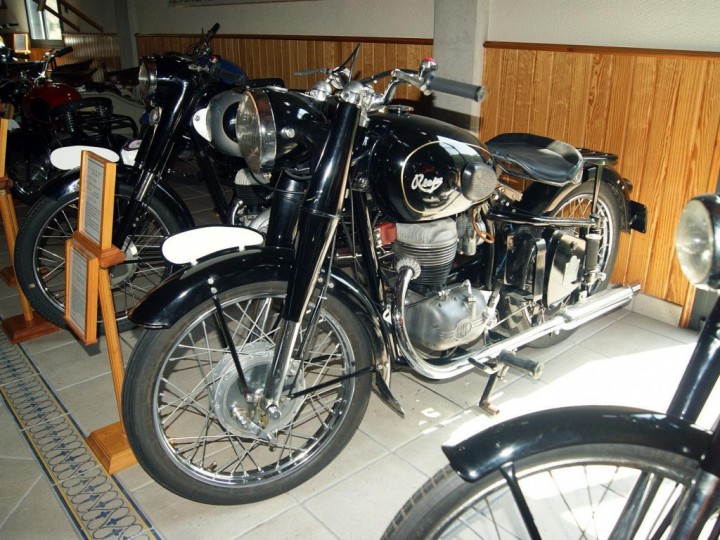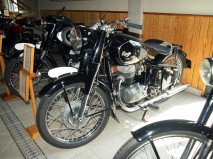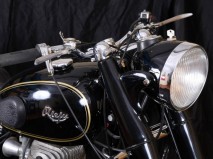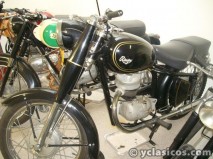1955 Rieju 175
RIEJU's first product in 1945 was what would later be called a "moped". It was a bicycle with a 38cc 4T auxiliary engine (French Serwa engine), direct transmission to the rear wheel, two speeds, and 1 CV. It even had the ability to reach 40Km/h! The No. 1 came equipped with a chrome petrol tank, was hand-welded, varnished... and an assembly similar to the "Rolls-Royce" concept (piece by piece with excellence). This allowed RIEJU to successfully begin its entrepreneurial adventure in the world of two-wheeled vehicles with engines.
Based on the 1945 model of the No. 1, the first RIEJU moped was manufactured in 1949. The moped had a small, French 50cc 4T independent transmission engine connected to a clutch, along with a gear shift. It was completely designed and developed by RIEJU. Therefore, July 1949 is considered the birth date of the No. 2.
The No. 2 was one of the most well known motorcycles of the time. It is without a doubt, one of our most appreciated historical mopeds.
In 1953, the 175cc RIEJU (with an AMC 4T engine) was born. The model was black in color with gold lines on the finish, and was equipped with a suspension system (hydraulic telescopic front fork and oscillating rear suspension with hydraulic shock absorbers). A partnership was created with the engine manufacturer AMC to supply the engines, since RIEJU had little experience with this type of engine, and was unable to self-manufacture the engine. The company also had a partnership with FITA in Figueres (where engines were manufactured under license). The 175 was based on the GIMA 175. RIEJU adapted and modified the design to manufacture a model that was lighter, easier to drive, and in general a more desirable design, especially since it provided a much more comfortable ride on the road. Additionally, the model boasted more efficient fuel consumption (due to improvements made to the RIEJU engine). This feature contributed to increased sales. 5,000 units were manufactured between 1953 and 1961. Afterwards (the chassis) its commercial run (propelled by a different type of engine - the Hispano Villiers) lasted another 4 years. During this time, 1,000 vehicles were produced per year. The great demand by distributors, and the power of the 175cc RIEJU gave great prestige to the company name.
With its carefully planned business strategies, RIEJU was able to survive (even on a small scale) while many Spanish industry giants in the sector failed. RIEJU always remained faithful to its initial idea of making the best of each moment.
Based on the 1945 model of the No. 1, the first RIEJU moped was manufactured in 1949. The moped had a small, French 50cc 4T independent transmission engine connected to a clutch, along with a gear shift. It was completely designed and developed by RIEJU. Therefore, July 1949 is considered the birth date of the No. 2.
The No. 2 was one of the most well known motorcycles of the time. It is without a doubt, one of our most appreciated historical mopeds.
In 1953, the 175cc RIEJU (with an AMC 4T engine) was born. The model was black in color with gold lines on the finish, and was equipped with a suspension system (hydraulic telescopic front fork and oscillating rear suspension with hydraulic shock absorbers). A partnership was created with the engine manufacturer AMC to supply the engines, since RIEJU had little experience with this type of engine, and was unable to self-manufacture the engine. The company also had a partnership with FITA in Figueres (where engines were manufactured under license). The 175 was based on the GIMA 175. RIEJU adapted and modified the design to manufacture a model that was lighter, easier to drive, and in general a more desirable design, especially since it provided a much more comfortable ride on the road. Additionally, the model boasted more efficient fuel consumption (due to improvements made to the RIEJU engine). This feature contributed to increased sales. 5,000 units were manufactured between 1953 and 1961. Afterwards (the chassis) its commercial run (propelled by a different type of engine - the Hispano Villiers) lasted another 4 years. During this time, 1,000 vehicles were produced per year. The great demand by distributors, and the power of the 175cc RIEJU gave great prestige to the company name.
With its carefully planned business strategies, RIEJU was able to survive (even on a small scale) while many Spanish industry giants in the sector failed. RIEJU always remained faithful to its initial idea of making the best of each moment.










